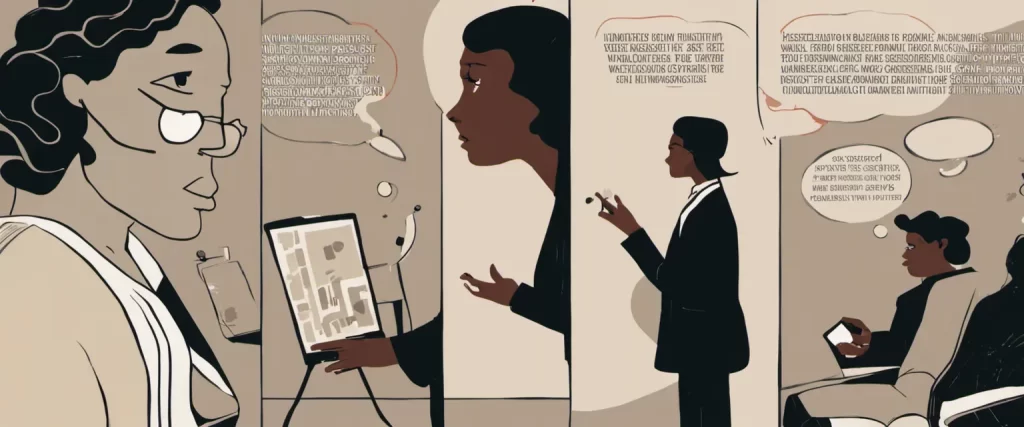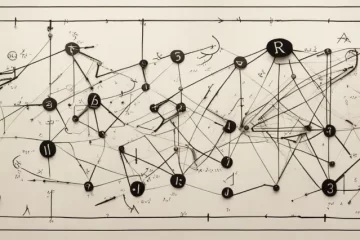Bridging the Gap: Why ‘Nonviolent Communication’ Is Essential in Today’s World

Communication is an essential skill that connects us as human beings, yet it is often riddled with misunderstandings, conflicts, and power struggles. In a world that appears more divided than ever, finding effective methods to foster understanding and compassion in our interactions has become crucial. Marshall Rosenberg‘s groundbreaking book, Nonviolent Communication, offers a transformative approach to communication that goes beyond surface-level conversations. By delving into the core of our needs, emotions, and vulnerabilities, Rosenberg provides a roadmap for building authentic connections and resolving conflicts peacefully. In this article, we will explore the key principles and strategies outlined in Nonviolent Communication, empowering you to revolutionize the way you communicate and navigate the complexities of human interactions.
What is Communication
Communication is the process of sending, receiving, and interpreting information between individuals or groups. It involves the transmission of messages through various channels, such as speech, writing, body language, and technology, to convey thoughts, ideas, feelings, or instructions. Effective communication requires both the sender and receiver to understand and interpret the message correctly. It plays a vital role in building relationships, resolving conflicts, sharing information, and creating understanding and collaboration among people.
Why is Communication Important to Us?
Communication is important to us for several reasons.
Firstly, communication enables us to express our thoughts, feelings, and ideas with others. It is a way to convey information, share experiences, and connect with others on an emotional and intellectual level. Effective communication allows us to build relationships, establish trust, and foster understanding among individuals.
Secondly, communication plays a crucial role in our personal and professional lives. It is essential for success in various aspects of life, such as education, career advancement, and social interactions. Good communication skills can help us express ourselves confidently, articulate our needs and desires, negotiate solutions, and collaborate effectively with others.
Moreover, communication promotes teamwork and cooperation. In any group or organization, effective communication ensures that everyone is on the same page, understands their responsibilities, and can work together towards a common goal. It enables effective problem-solving, decision-making, and coordination among team members.
Additionally, communication helps in resolving conflicts and addressing misunderstandings. It allows individuals to express their concerns, listen to others, and find mutually agreeable solutions. Without effective communication, conflicts may escalate, relationships may deteriorate, and issues may remain unresolved.
Furthermore, communication is essential for personal growth and development. It enables us to learn from others, gain new knowledge, and broaden our perspectives. Through communication, we can seek guidance, share experiences, and access information that allows us to expand our understanding of the world and ourselves.
In conclusion, communication is vital because it is the key to building connections, achieving personal and professional success, promoting teamwork, resolving conflicts, and fostering personal growth. It is an essential aspect of our lives that allows us to express ourselves, understand others, and navigate through a complex and interconnected world.
Unlocking Communication from Nonviolent Communication

Nonviolent Communication Introduction
“Nonviolent Communication” by Marshall Rosenberg is a guidebook that presents a transformative approach to communication and conflict resolution. The book explores the power of effective communication in fostering understanding, empathy, and collaboration. It offers a practical framework that helps individuals express their feelings and needs, listen empathetically, and find mutually satisfying solutions to conflicts.
Rosenberg begins by explaining the concept of nonviolent communication, emphasizing the intention to connect with others rather than focusing on blame or judgment. He breaks down the four components of this approach: observation, feeling, need, and request. Through examples and exercises, he demonstrates how to observe without evaluating, connect with emotions, identify underlying needs, and make clear requests.
The author also explores how to handle difficult conversations and conflicts, highlighting the importance of empathy in establishing rapport and trust. He emphasizes the significance of active listening, acknowledging and validating emotions, and fostering understanding in order to effectively resolve conflicts.
Rosenberg delves into the concept of empathy and how it can bridge emotional gaps between individuals. He emphasizes the power of connecting on a human level and expanding our capacity for understanding and compassion. The book also addresses the challenges of dealing with anger, criticism, and manipulative language, providing strategies for responding with empathy and maintaining connection.
Throughout the book, Rosenberg shares numerous real-life examples and anecdotes that illustrate how nonviolent communication can transform relationships, whether they be personal or professional. He challenges conventional thinking patterns and encourages readers to approach communication with empathy, authenticity, and a focus on shared humanity.
In summary, “Nonviolent Communication” provides a practical and insightful guide to improving communication and resolving conflicts through empathy and understanding. It offers a transformative approach to fostering connection, embracing emotions, and finding mutually satisfying solutions.
Communication Methods
In the book “Nonviolent Communication” by Marshall Rosenberg, several communication methods are mentioned. Here are a few examples:
1. Observation: This method emphasizes the importance of observing and describing the concrete actions or behaviors that are affecting our well-being, rather than judging or evaluating others.
2. Feelings: Recognizing and expressing our feelings help us understand our own needs and communicate them effectively to others. It involves identifying and verbalizing our emotional responses to specific situations.
3. Needs: Identifying our underlying needs and values is essential for effective communication. By understanding and communicating our needs, we can focus on finding mutually satisfying solutions.
4. Requests: Instead of making demands or using coercive language, the book suggests making clear, concrete, and doable requests to ensure that our needs are met.
5. Empathy: Empathy is a method of active listening and showing understanding towards others by connecting with their feelings and needs. It involves putting oneself in the other person’s shoes and trying to see the world from their perspective.
6. Self-expression: The book emphasizes the importance of honestly expressing oneself without blaming, criticizing, or attacking others. It encourages individuals to communicate their needs and feelings authentically while taking responsibility for their own experiences.
7. Nonviolent Communication Process: The book also outlines a four-step process (observation, feeling, need, and request) to guide individuals in effectively communicating their observations, feelings, needs, and requests.
These are just a few of the communication methods discussed in “Nonviolent Communication” by Marshall Rosenberg. The book provides further insights and practical techniques for transforming conflict and cultivating empathic connections.
Nonviolent Communication Quotes
Nonviolent Communication quotes as follows:
1. “What I want in my life is compassion, a flow between myself and others based on a mutual giving from the heart.”
2. “Instead of resisting negative judgments, we might listen for what people are needing when they express their judgments.”
3. “When we give from the heart, we do so out of the joy that springs forth whenever we willingly enrich another person’s life.”
4. “Honesty intermingled with blame is far more harmful than an outright lie.”
5. “Listening with empathy is the most potent aspect of nonviolent communication.”
6. “Giving generously, with love and joy, enhances our sense of self-worth.”
7. “Judgments of others are alienated expressions of our own unmet needs.”
8. “Giraffes (metaphorically representing compassionate communication) enjoy rich relationships because they keep their needs alive and are willing to make requests to get them met.”
9. “Real power is the ability to connect with, empathize, and inspire others.”
10. “We have the power to transform our habits of thinking in ways that will transform our lives.”

More Books About Nonviolent Communication by Marshall Rosenberg
1. “Nonviolent Communication: A Language of Life” by Marshall Rosenberg
No book recommendation list on Nonviolent Communication is complete without including its original source. This seminal work by Marshall Rosenberg explains the principles of NVC, offers practical guidance, and highlights the transformative power of compassionate communication. It is the essential starting point for anyone interested in this topic.
2. The Power of Moments: Why Certain Experiences Have Extraordinary Impact” by Chip Heath and Dan Heath
Although not directly related to Nonviolent Communication, this book explores the power of creating meaningful experiences. It offers insights into how to make interactions more impactful, an aspect that can be applied to communicating nonviolently. By leveraging the principles discussed in “The Power of Moments,” one can enhance their NVC skills and create deeper connections with others.
3. “When I Say No, I Feel Guilty: How to Cope, Using the Skills of Systematic Assertive Therapy” by Manuel J. Smith
This book delves into the art of asserting oneself without resorting to aggression or submission. It provides practical techniques for standing up for oneself effectively, while still maintaining empathy and respect for others. Combining the principles of assertive communication from Smith’s book with Nonviolent Communication can help individuals express their needs and boundaries more authentically.
4. Men Are from Mars, Women Are from Venus” by John Gray
While exploring the differences in communication styles between men and women, John Gray’s book provides valuable insights into relationship dynamics. Understanding these differences can aid in bridging conflicts and developing more empathy and compassion when communicating nonviolently. By grasping the nuances highlighted in “Men Are from Mars, Women Are from Venus,” individuals can incorporate these understandings into their NVC practice and create stronger connections.
5. “Nonviolent Communication Companion Workbook” by Lucy Leu
Whether you are new to Nonviolent Communication or already well-versed in its principles, this workbook offers practical exercises and tools to deepen your understanding and application of NVC concepts. With a collection of exercises, examples, and real-life stories, this companion workbook will guide you in implementing NVC principles into your everyday life, allowing you to experience its transformative effects.
By reading these five books, you will gain a comprehensive understanding of Nonviolent Communication while also exploring related topics such as creating impactful moments, asserting oneself effectively, understanding relationship dynamics, and applying NVC principles in real-life situations. This collection offers a well-rounded approach to developing your communication skills and fostering deeper connections with others through compassion and empathy.



10 Comments
Jane Eyre: A Feminist Classic · 12/07/2023 at 17:14
[…] Jane Eyre, by Charlotte Bronte, is a coming-of-age story centered around the titular character, an orphaned young woman who faces numerous challenges and hardships throughout her life. The novel begins with Jane’s difficult childhood, living with her cruel aunt and cousins at Gateshead Hall. She is eventually sent to Lowood Institution, a harsh and oppressive charity school, where she endures mistreatment and limited opportunities for self-expression. […]
Ignite Your Creative Spark with Julia Cameron's The Artist's Way: A Must-Read Book - singleread.com · 12/20/2023 at 00:01
[…] Personal fulfillment: Engaging in creative activities can bring a sense of joy, accomplishment, and self-expression. It allows us to explore our passions, interests, and unique perspectives, nurturing our personal […]
The Art of Writing: A Review and Recommendation of Ann Lamott's Classic for Every Aspiring Writer - singleread.com · 12/22/2023 at 12:29
[…] Self-expression and Creativity: Writing provides an outlet for self-expression and allows us to explore our […]
The Art of Effective Communication: Exploring Daniel Goleman's 'Social Intelligence' - singleread.com · 12/25/2023 at 17:11
[…] Emotional self-expression: This refers to the ability to express one’s emotions and feelings in a clear and […]
Psychological Healing: Unlocking Your Emotional Freedom with 'Emotional Blackmail' by Susan Forward - singleread.com · 12/25/2023 at 17:13
[…] aspect of psychological healing. Engaging in activities that promote relaxation, self-reflection, self-expression, and self-compassion can contribute to one’s overall […]
Igniting Creativity: Exploring Robert Fritz's "The Path of Least Resistance - singleread.com · 01/09/2024 at 00:01
[…] Self-expression: Creativity allows us to express our thoughts, emotions, and ideas in unique and personal ways. It […]
Frida:Examine Feminism in Hayden Herrera's Biography · 01/09/2024 at 00:09
[…] Self-Expression: Frida Kahlo used her art as a medium to express herself authentically. Her paintings often […]
Unlock Your Creative Potential: Discover Zen in the Art of Writing - singleread.com · 01/19/2024 at 00:02
[…] Self-expression and Creativity: Writing provides an outlet for self-expression, allowing us to share our unique […]
Reviving Artistic Masterpieces: Unlocking Art History through 'Bright Earth' - singleread.com · 01/20/2024 at 00:10
[…] and the ability to interpret and communicate ideas effectively. It also provides opportunities for self-expression and […]
Unleash Your Writing Potential with 'On Writing Well' by William Zinsser - singleread.com · 02/04/2024 at 00:04
[…] Expression: Writing provides an outlet for self-expression. It enables us to express our emotions, experiences, and perspectives in a creative and compelling […]